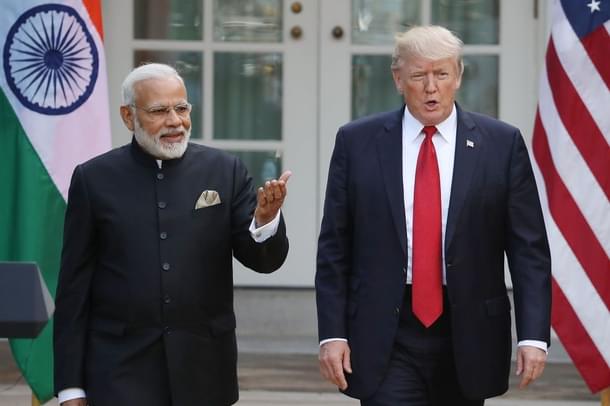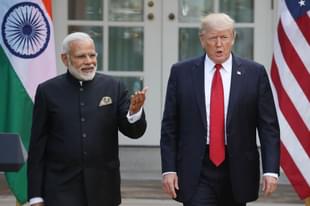World
What To Expect From The Second India-US 2+2 Ministerial Dialogue In Washington?
Kriti Upadhyaya
Dec 17, 2019, 12:44 PM | Updated 12:09 PM IST
Save & read from anywhere!
Bookmark stories for easy access on any device or the Swarajya app.


The second India-US 2+2 Ministerial Dialogue is to be held in Washington on 18 December. The timing of the dialogue could not be more opportune for the world’s two largest democracies.
Historical alignments are shifting; America has increasing tensions with traditional partners such as Korea, Japan and NATO.
India, for its part, has become more isolated due to provocative policy moves on issues like Kashmir and the Citizenship Amendment Bill. This dialogue will likely see traction between the two countries in three broad areas — interoperability, regional cooperation, and people-to-people contact.
The India-US 2+2 ministerial-level dialogue is a novelty of the President Donald Trump and Prime Minister Narendra Modi era.
The inaugural dialogue was held in New Delhi on 6 September 2018. The dialogue series is “focus(ed) on deepening bilateral strategic and defence cooperation, exchanging perspectives on global developments, and our shared leadership in the Indo-Pacific region.”
The first dialogue was quite successful, resulting in multiple agreements that furthered India-US defence ties. These include the Communications, Compatibility and Security Agreement (COMCASA) which was signed as an enabling agreement between India and the US.
Further, the two countries agreed to an inaugural tri-service exercise. This inaugural tri-service exercise, ‘Exercise Tiger Triumph’, happened last month as American and Indian sailors “arrived aboard the USS Germantown in Vishakhapatnam, India.”
The second India-US 2+2 Ministerial Dialogue is significant for many reasons. It is the first dialogue happening in the US, the first 2+2 dialogue for both the Indian ministers and the US defence secretary, and will be the first official visit of Rajnath Singh to the US in his role as Defence Minister. There are three broad areas where new elements of cooperation should be emphasised:
Interoperability: this is important for India for two reasons.
First, India is a net defence importing nation, which means that one of the problems India will be facing in the future with increased sophistication of defence equipment is that its defence technologies from different nations will have difficulty communicating with each other.
Second, as India tries to diversify defence procurement and move closer to the US, France and Israel for its defence needs, interoperability between the US and Indian systems is key for further strengthening the defence partnership between the two democracies.
The four “enabling” agreements aim to strengthen this partnership. With the Logistics Exchange Memorandum of Agreement (LEMOA) first signed, and COMCASA signed last year, all eyes are now on the Industrial Security Annex (ISA) and the Basic Exchange and Cooperation Agreement for Geo-spatial Cooperation (BECA).
Although the US and India are still ironing out the details of BECA, which allows India access to American geo-spatial maps, ISA will likely be concluded in the 2+2 meeting.
This will be a significant step towards interoperability as ISA is focused on ensuring India does not share US technology with other countries while also having protections in place against industrial espionage (Indian authorities will help monitor Indian private firms’ security practices).
Thus, the ISA will ensure confidence building amongst the two sides so that defence cooperation can continue to intensify.
Regional cooperation: this is perhaps the most important area of focus of these dialogues, and of growing significance as India continues engaging with the quad and seeks to limit China’s influence in the Indian Ocean region.
The US, in turn, is eyeing India to become more proactive in the Indo-Pacific. Our respective Indo-Pacific strategies will be an important topic for the 2+2 dialogue, coming just after India convened two dialogues focused on the Indo-Pacific and ocean security.
The India-US defence counterparts also held a meeting on the Indo-Pacific in Bangkok less than a month back on the sidelines of the ASEAN defence ministers’ meeting.
People-to-people ties: the “Howdy Modi” event underscores the point that people-to-people ties are a crucial element of the India-US relationship.
The Indian community in the US is the most educated ethnic group in America even surpassing Asian Americans collectively, and Americans overall.
Indian Americans are also the richest ethnic group with the Indian American household annual median income ($88,000) being significantly higher than that of Asian Americans ($66,000), and overall Americans ($49,800).
With the 2020 general election approaching and Indian Americans becoming an important vote bank, issues that matter to these new Americans (87.2 per cent of Indian Americans in the US on 2010 were foreign born) like educational, work, and investment visas, are sure to be talking points.
Although immediate concessions on these areas as desired by the Indian government are unlikely, it is likely that some headway will be gained through discussions and deliberations at the 2+2 dialogue.
India and the US are now moving beyond the cliches of a relationship merely defined as one between natural democracies to a more focused, and strategic partnership where both sides have much to gain.
As India and the US chart this new chapter that has been evolving in the Trump-Modi era, dialogues like the 2+2 are important platforms for strengthening the framework of our security relationship.
Kriti Upadhyaya is a research associate for the Wadhwani Chair in U.S.-India Policy Studies at the Center for Strategic and International Studies (CSIS) in Washington D.C. USA. In her role, she focuses on U.S.-India economic ties and Indian federal economic reforms.





